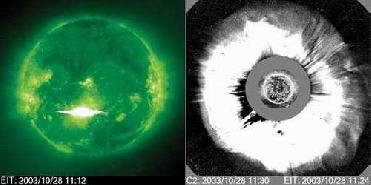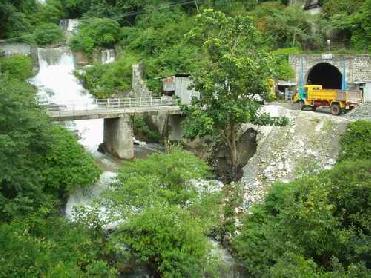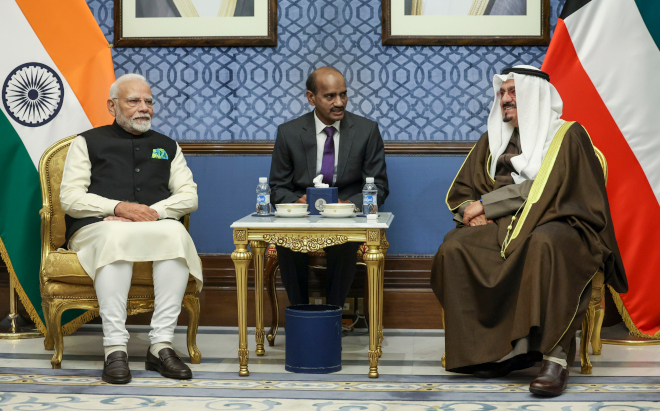
A severe space weather event is likely when an intense flare occurs on the Earth-facing side of the sun. In 2003, this flare (left image) is followed immediately by an enormous interplanetary blast wave (right image) called coronal mass ejection or CME that propagates rapidly away from the sun towards Earth. Depending on severity and nature of the storm, the collision with Earth's magnetic field called a geomagnetic storm can affect satellites, air travel and power grids. Credit: NASA
WASHINGTON (BNS): Have you ever imagined how extreme solar eruptions could severely effect communications, power grids and other technology on the Earth?
Recently, NASA funded a study to understand the Sun, its solar processes and the interaction of solar plasma and radiation with Earth, other planets and the universe. Understanding the connections between the Sun and its planets will allow better prediction on the impacts of solar activity on humans, technological systems and even the presence of life itself in the Universe.
Conducting the study, the National Academy of Sciences, Washington, provided some of the first clear economic data that effectively quantifies today's risk of extreme conditions in space driven by magnetic activity on the Sun and disturbances in the near-Earth environment. Instances of extreme space weather are rare and are categorised with other natural hazards that have low frequency but high consequences.
Richard Fisher, director of the Heliophysics division at NASA Headquarters in Washington said that the Sun is Earth's life blood. “To mitigate possible public safety issues, it is vital that we better understand extreme space weather events caused by the Sun's activity,” Fisher said.
Explaining the study, the NASA official said that besides emitting a continuous stream of plasma called the solar wind, the Sun periodically releases billions of tonnes of matter called coronal mass ejections. These immense clouds of material, when directed toward Earth, can cause large magnetic storms in the magnetosphere and upper atmosphere. Such space weather can affect the performance and reliability of space-borne and ground-based technological systems, he said.
The study said that space weather can produce solar storm electro-magnetic fields that induce extreme currents in wires, disrupting power lines, causing wide-spread blackouts and affecting communication cables that support the Internet. Severe space weather also produces solar energetic particles and the dislocation of the Earth's radiation belts, which can damage satellites used for commercial communications, global positioning and weather forecasting. Space weather has been recognised as causing problems with new technology since the invention of the telegraph in the 19th century, the study said.
The NASA official said that a catastrophic failure of commercial and government infrastructure in space and on the ground can be mitigated through raising public awareness, improving vulnerable infrastructure and developing advanced forecasting capabilities. Without preventive actions or plans, the trend of increased dependency on modern space-weather sensitive assets could make society more vulnerable in the future, they said.
The study has made an assessment of the likely damage from significant space weather during the next two decades. Daniel Baker, professor and director of the Laboratory for Atmospheric and Space Physics at the University of Colorado, Boulder, and chairman of the report said that from a public policy perspective, it is quite significant that we have begun the extremely challenging task of assessing space weather impacts in a quantitative way.
“Whether it is terrestrial catastrophes or extreme space weather incidents, the results can be devastating to modern societies that depend in a myriad of ways on advanced technological systems. We were delighted that NASA helped support bringing together dozens of world experts from industry and government to share their experiences and begin planning of improved public policy strategies,” Baker said.
The sun is currently near the minimum of its 11-year activity cycle. It is expected that solar storms will increase in frequency and intensity toward the next solar maximum, expected to occur around 2012, he said.
 Previous Article
Previous Article Next Article
Next Article













The Indian Air Force, in its flight trials evaluation report submitted before the Defence Ministry l..
view articleAn insight into the Medium Multi-Role Combat Aircraft competition...
view articleSky enthusiasts can now spot the International Space Station (ISS) commanded by Indian-American astr..
view article